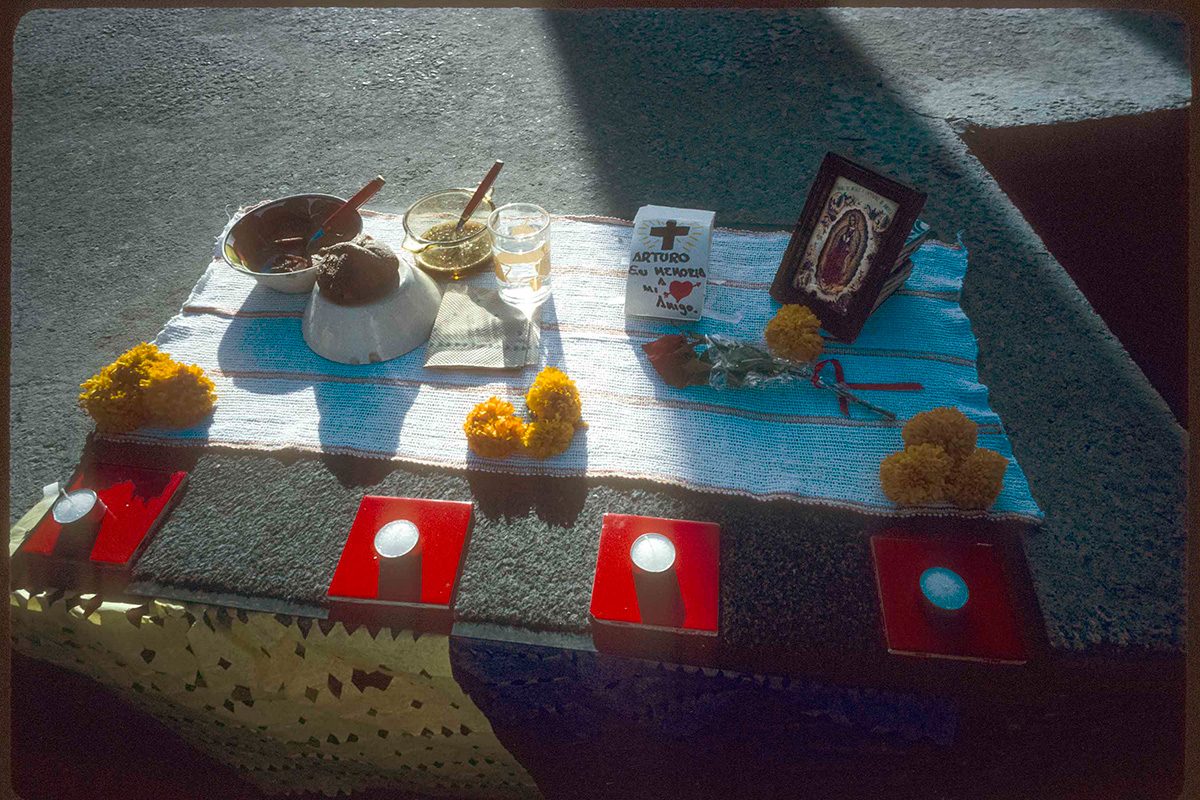Rooted in Mexican indigenous ritual, the annual Día de los Muertos (Day of the Dead) celebration that honors those who have passed on has been transformed over centuries. In true folk tradition, the celebration has many variants depending on social class, geography, and belief system.
The contemporary version often includes the altar or ofrenda, a procession or parade, and certain foods. We begin with the essential elements for constructing an altar to loved ones: salt, herbs, water, copal (a tree resin used as incense), cempazuchitl (marigolds), candles, food, and photographs. We decorate an arch and a pathway that lead the souls to the altar, which traditionally consists of seven or nine levels. Some of the newer elements come from Catholic tradition—after all, it is a liturgical celebration blended into the indigenous one—such as the crucifix and saints’ images or statues. Other innovations include papel picado, the intricately cut paper art that adorns the altar.
In Mexico, the calaveras, or sugar skulls, and literary calaveras—satirical poems—were added around the time that Jose Guadalupe Posada, a famous printer, popularized the satirical image of La Catrina and the poems through a series of annual publications in the early twentieth century. Posada’s La Catrina satirized Mexicans who looked to abandon their indigenous roots in favor of aristocratic European traditions, as well as politicians and other elites.


Chicanx artists in East Los Angeles—especially associated with Self Help Graphics & Art—and the Mission District in San Francisco are credited with celebrating the earliest truly alternative form of the tradition in the 1970s. Where I grew up in the Southwest, the Chicanx community had been celebrating Día de los Muertos for generations, only not as flamboyantly, with modest rituals that included annual visits to the cemetery in homage and remembrance of those who have died.
In my recollection of visiting graveyards in both Laredo, Texas, and Nuevo Laredo, Mexico, several things stand out: cleaning the tombs and decorating them with flowers—marigolds plus other seasonal flowers like manita de león and sunflowers. I remember the prayers, the incense, and the food left on the tombs which we also enjoyed: caña (sugar cane) and certain seasonal fruits, but not pan de muerto, the bread prepared with anise seeds that has become de rigeur in contemporary celebrations.
Now, transformations are constant. More and more communities in the United States are adopting the tradition celebrated a day after Halloween, on All Saints’ Day in the Christian calendar followed by All Souls’ Day on November 2. In Chicago, San Francisco, New York City, Dallas, Houston, San Antonio, Albuquerque, Tucson, and even Kansas City, Missouri, museums and cultural centers are hosting celebrations that include altar contests, meals that include pan de muerto con champurrado (chocolate), and elaborate musical programs and poetry readings.


Has the tradition changed? Of course. Has it left behind the indigenous roots or the Catholic meaning? Not entirely. There is no wrong way to honor the dead, and these attempts go beyond the commercialization and secular celebration to explore a deeper sense of the fragility of life. In these times of Black Lives Matter, of dark and sinister forces that incite mass killings, we remain jubilant and celebrate life by honoring the dead.
Each year, at the San Anto Cultural Arts Center in San Antonio, community artists gather around a mural to add the names of new victims of violence. All across town, artists and community join in celebration, remembering those who have left and rejoicing in those who are still with us.
Norma Cantú is the Murchison Distinguished Professor of the Humanities at Trinity University in San Antonio, Texas, and a long-time collaborator with the Smithsonian Folklife Festival.


